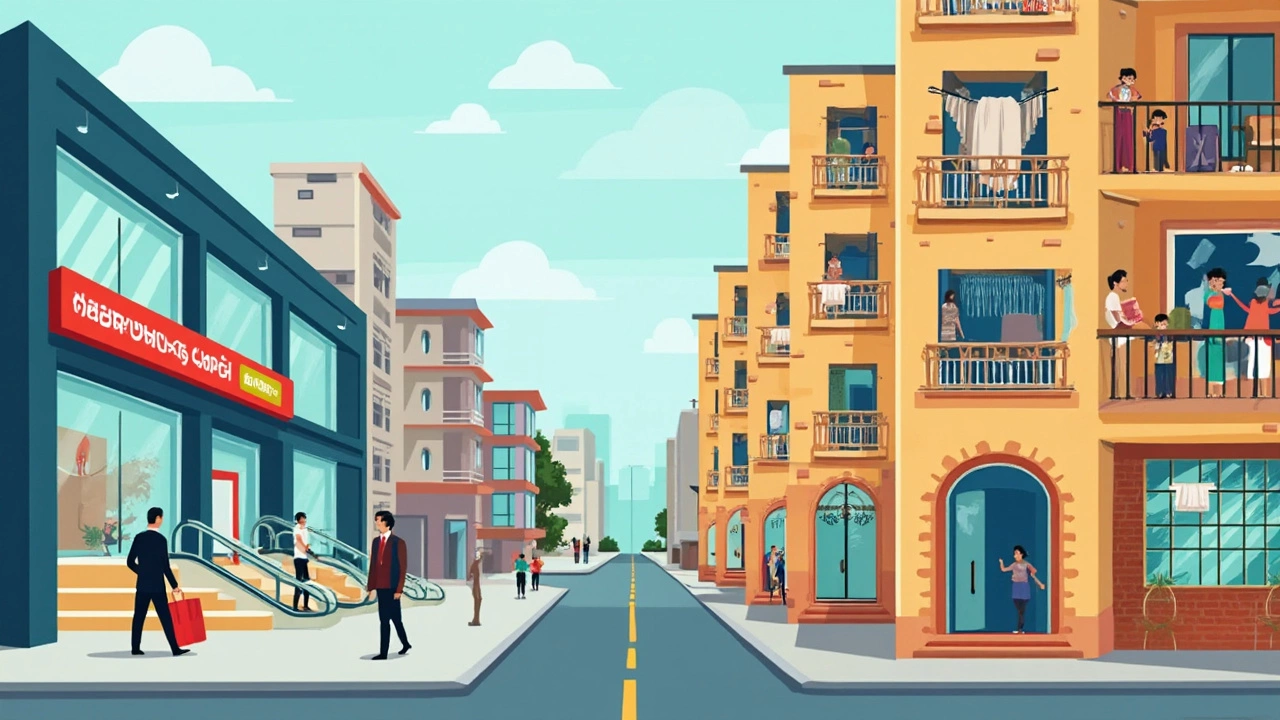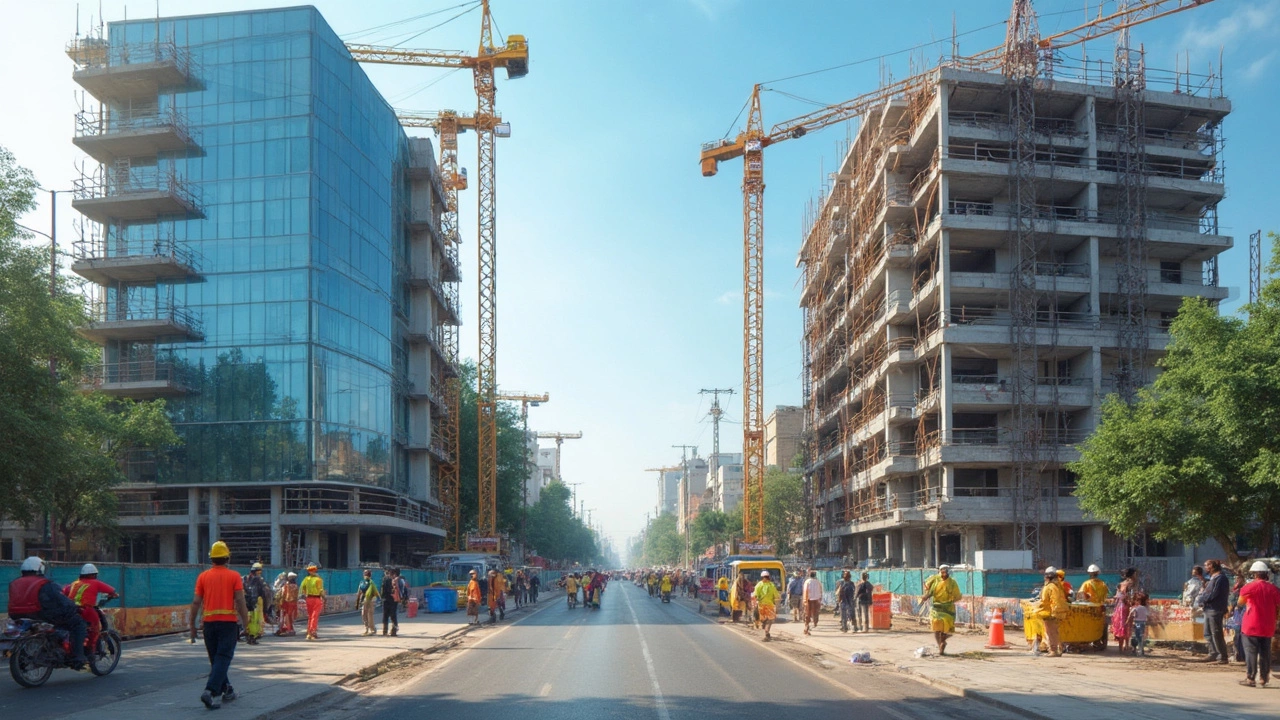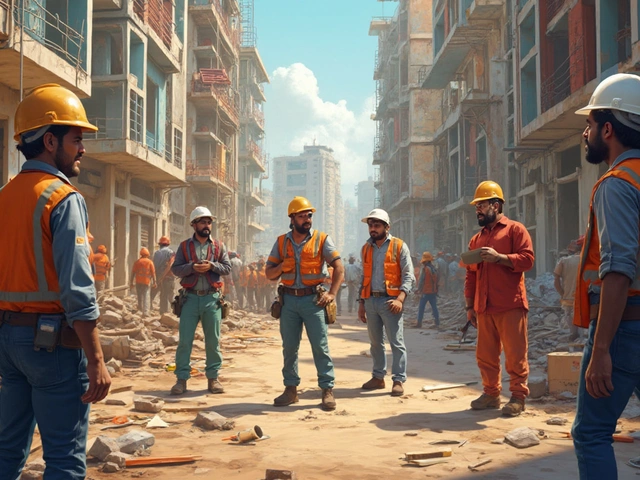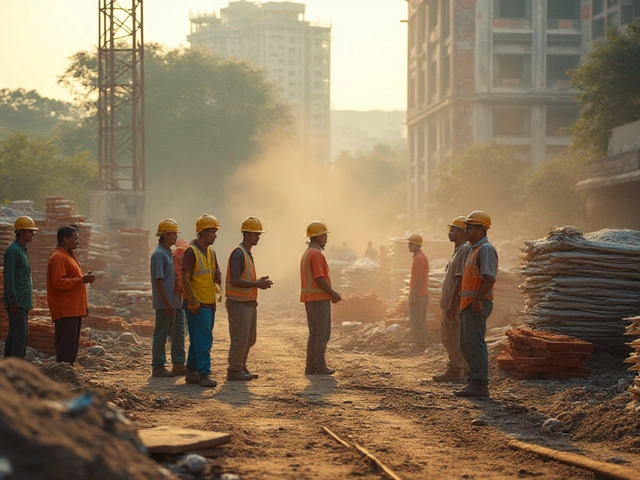Ever wondered what makes a building commercial or non-commercial? You're not alone—this can get confusing fast, especially with all the mixed-up terms people throw around. The truth is, the type of construction depends on the purpose of the building. If you know why something’s being built, you’ll usually know whether it’s commercial or not.
Commercial construction isn't just about size or budget; it’s about how the building will be used. Hospitals, shopping malls, warehouses, hotels—these places exist for business. Schools and government offices fall into a gray area, but most of the time, anything designed for business activities or making money gets slapped with the ‘commercial’ label.
You don’t need to be a construction pro to figure out the basics. If you’re looking at a project and people will work there, shop there, or pay for a service, that’s a big hint—it’s commercial. Residential and certain nonprofit projects, on the other hand? Not commercial. Keep reading, and let’s break down why this matters, what sorts of buildings fit each category, and how to spot the difference before you even see a blueprint.
- Defining Commercial Construction
- What Counts as Non-Commercial?
- Key Differences in Projects
- Spotting the Category: Tips and Examples
Defining Commercial Construction
When people talk about commercial construction, they’re really just talking about building spaces where some kind of business happens. It’s all about the function: if a construction project is meant for making sales, providing services, or hosting workers who aren’t living there, that’s commercial. Think of things like office towers, restaurants, gyms, banks, large stores, or even storage facilities. The defining factor is pretty simple—money changes hands, or business is being run inside those walls.
Here’s a handy way to spot a commercial site:
- It’s designed for high foot traffic, like retail centers or malls.
- There are spaces for workers—think cubicles, meeting rooms, or shared kitchens.
- There’s compliance with stricter safety, fire, and disability codes.
- The building often needs specialized features, like loading docks, elevators, or big HVAC systems.
- It usually requires permits that are more detailed and expensive than for a regular home.
Commercial projects usually fall into these common categories:
- Office Buildings (from small offices to huge skyscrapers)
- Retail and Shopping Centers
- Warehouses and Distribution Facilities
- Restaurants and Food Service
- Hotels and Lodging
- Healthcare Facilities (like clinics and hospitals)
- Mixed-Use Developments (combos of shops, offices, and sometimes even apartments)
Just to give you an idea, the U.S. commercial construction market was valued at over $530 billion in 2023—a number that shows just how massive and vital these projects are. Here’s a quick view of some typical commercial building types and how common they are:
| Type | Percent of Market |
|---|---|
| Office/Business | 25% |
| Retail/Shopping | 20% |
| Warehouse/Industrial | 18% |
| Healthcare | 10% |
| Hospitality | 8% |
| Other Commercial | 19% |
One more thing—commercial construction usually means working with bigger crews, tighter schedules, and way more building codes than you’d ever see on a home reno. Most commercial projects need a deep bench of specialized pros, from architects who know ADA rules, to contractors who can handle large-scale mechanical and electrical systems. So, if you’re looking at a build and it’s packed with business plans, strict regulations, or a complicated approval process, you’re definitely in the world of commercial construction.
What Counts as Non-Commercial?
If a building isn't focused on making money or hosting a business, it's probably non commercial construction. Think homes, apartment complexes, and pretty much anywhere someone lives full-time. These projects are about shelter, not sales. Private houses, duplexes, condos, plus even affordable housing projects—they're all in this camp.
Schools and religious structures muddy the waters a bit. Public schools, churches, and community centers don’t run to turn a profit, even if the construction looks just as involved as a mall or medical center. Sometimes they might charge for certain events or services, but the main goal isn’t making cash—it's serving people. That’s the big dividing line.
Here are typical examples of non commercial construction projects:
- Single-family homes
- Apartment buildings strictly for residential use
- Public schools and universities
- Churches, temples, mosques
- Libraries and community rec centers
- Public parks and playgrounds
It’s not just about who's paying—it’s about how the property is used. If the people using the building are living, worshipping, or learning (not selling or buying), it fits the non commercial category. In a 2023 survey, about 60% of all new construction permits in the US were for these residential and community-focused projects. That’s a massive chunk of the industry, even if you mostly hear about skyscrapers and stores on the news.
When planning a project, always ask: Is this for people to live, learn, or gather, rather than buy or work? Answer honestly, and you'll know if you’re talking about non commercial construction.

Key Differences in Projects
So what actually sets commercial construction apart from non-commercial (mostly residential) projects? A lot more than just the number of floors or the price tag. The purpose, the process, the rules—pretty much everything shifts when money-making and business use are in play.
For starters, the design phase for commercial jobs looks a lot different. Commercial buildings need to fit lots of people, heavy equipment, or specific brands—think about a restaurant vs. a house kitchen. Architects need to follow codes made for public use, such as ADA requirements (making spaces accessible for people with disabilities), fire codes, and usually, more demanding structural standards. Residential codes are usually stricter about comfort and personal safety, but commercial codes hammer down on public safety and efficiency.
Then there’s the permit process. Getting something approved for commercial construction is way tougher. Cities often require special permits, sign-offs from fire marshals, and even traffic studies if the new building is going to attract a lot of people. For a regular house, the process is faster and less strict.
Here’s where the money math gets interesting: commercial jobs move fast, cost more upfront, and usually involve multiple teams trading off different jobs at the same time. Residential projects are slower, more personal, and you usually deal with one main contractor. Mess up in a commercial build, and you can lose a ton of cash fast, or end up with a lawsuit before you even open.
| Aspect | Commercial Construction | Non-Commercial Construction |
|---|---|---|
| Main Use | Business, Services, Retail | Living, Residential |
| Code Requirements | Strict (ADA, public safety, lots of permits) | Residential-specific, fewer public rules |
| Construction Timeline | Short, high-pressure, lots of crews | Longer, single contractor focus |
| Project Size | Larger, more complex | Smaller, simpler |
Another big thing is insurance. Commercial builders need more coverage—liability, property, workers’ comp—since more is at risk. If you’re ever in doubt, ask to see what insurance and permits a builder carries; their answer usually tells you what lane they’re in.
Finally, commercial jobs usually mean working with a bunch of specialists—engineers, planners, project managers. Residential usually has an architect and a builder, maybe a designer for fancier homes, but it’s more direct. Commercial building is seriously “all hands on deck.”
Spotting the Category: Tips and Examples
Figuring out whether a building project is commercial construction or not isn’t rocket science, but there are a few easy signs you can look for. Let’s talk through them so you don’t get tripped up, whether you’re just curious or actually planning a job.
If the building or space is going to be used to run a business, store stuff for a company, or provide services that people pay for, you’re pretty much looking at commercial construction. Think about places like supermarkets, gyms, strip malls, restaurants, small shops, hotels, offices, gas stations, and car dealerships. All these are dead giveaways.
On the other hand, if the building is for people to live in—like houses, apartment buildings with four or fewer units, or duplexes—it’s non-commercial. But if you see a massive apartment complex with amenities like gyms and lobbies managed by a company, it’s often classed as commercial because it’s operated as a business, not just a home.
- If a project has a fire alarm system that must follow codes made for businesses (like NFPA 101 or IBC rules for assembly spaces), it’s commercial.
- Building permits labeled "Assembly," "Mercantile," or "Business" are commercial projects. Permits that say "Residential" are non-commercial.
- Most warehouses, factories, and distribution centers are always commercial, even if they’re smaller than you’d expect.
- Churches and community centers—while sometimes tax-exempt—are usually built under commercial permits because people gather there in big numbers.
Just to make it clearer, here’s a quick breakdown:
| Type | Commercial? | Why? |
|---|---|---|
| Restaurant | Yes | Business sells food/services |
| Grocery Store | Yes | For-profit, public access |
| Private Home | No | Personal living space |
| Large Apartment Building (Managed) | Yes | Income-generating property |
| School | Depends | Public schools often follow commercial codes; smaller private schools might not |
| Warehouse | Yes | Business storage/distribution |
If you’re about to pull a permit or hire a designer, double-check which category your project falls in. It changes what rules you need to follow—right down to plumbing fixtures, accessibility, and parking spaces. And don’t assume size is the only factor; it’s almost always about use and management, not just square footage. If you’re unsure, your local city permits office or a legit commercial construction contractor can point you in the right direction fast.






